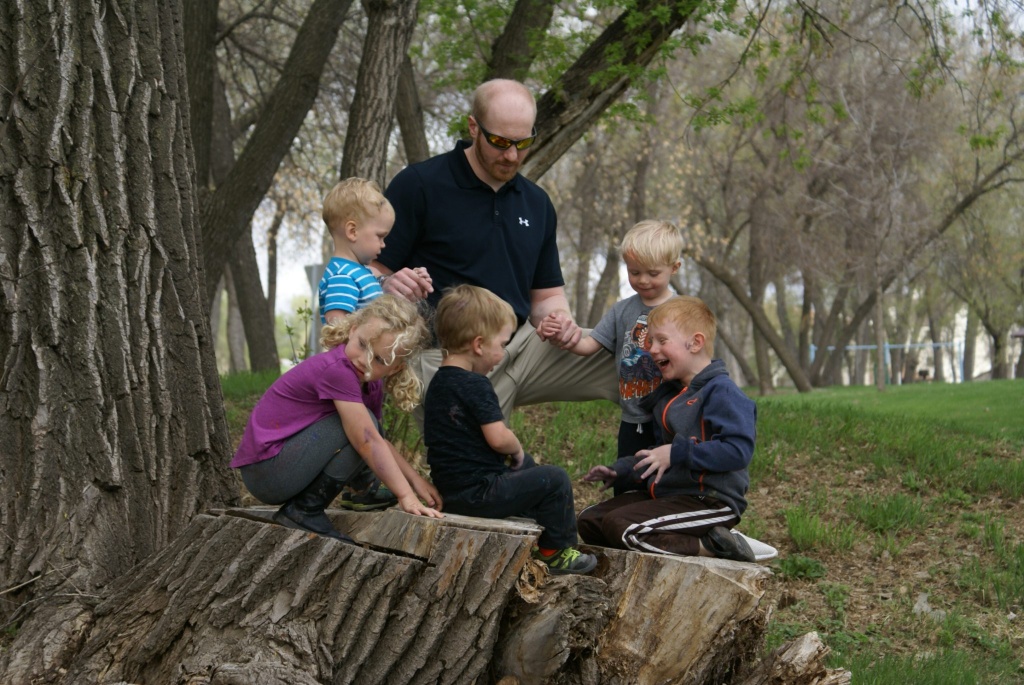 by Paula Redmann | Submitted Photos
by Paula Redmann | Submitted Photos
The classroom isn’t a traditional one. In fact, it’s far from it. There are no desks or pencil sharpeners. You won’t find a folder or a pile of papers. There’s nary a notebook.
That’s because this is Tinkergarten, and the classroom is nature. Tinkergarten is a national organization that is just starting to sprout in the child enrichment scene in Bismarck. Trained leaders, like Nikki Bushaw, Beth Heyne, and Bri Weisbeck, provide the framework and guidance for the 18-month to eight-year-old students, called “explorers,” and their parents, called “guides.”
It’s not a drop-off-see-you-later program, explains Bri. Tinkergarten is very much a child centered, parent—or grandparent or caregiver—participation experience. A recent Tinkergarten class was meeting in an open, green space in Sertoma Park in Bismarck. There were wee ones, mid-size wee ones, and bigger wee ones, each ready to dig in and get busy. There was painting involved. Some of the paint went on cardboard boxes. Some of the paint strayed to skin, or maybe a sibling’s sock.
Even with an open and creative setting, there’s still a structure to the program.
“There are five parts to each hour and 15-minute class,” says Bri. “We have an opening activity, circle time, the main activity, guided play, and a celebratory/snack time at the end. We’re good stewards of the land and we leave without a trace of us being here.”
One of the main objectives of Tinkergarten is to get kids creating and exploring.
“Kids are surrounded by technology,” says Bri. “Sometimes they are forgetting how to play, how to create, how to socialize with other children or adults, and how to collaborate and work with others. Tinkergarten is a way to let kids explore, learn, and have fun.”
Here’s how Tinkergarten works:
The Tinkergarten leaders go through a four-week, 16-hour rigorous training and interview process as well as a background check before they can officially lead a group. All the classroom materials are supplied by the Tinkergarten program and by nature. The leaders provide the guidance, but they also step back to let each child’s imagination run wild, and to let the adults both observe and engage, not only with their child, but with other kids—and adults—in the program. Once the leaders complete their training, classes can begin.
“Each of the eight sessions of Tinkergarten has a theme and a purpose,” explains Bri. “The part I like as a parent is that I don’t have to plan, set up, or take down an activity for my child. That’s all done for me, so I can just show up and join in. It allows me to engage with other kids and other parents. Tinkergarten is very much evidence based, play focused, and available for children with varying abilities.”
Brittany Kerzman enrolled her three children in Tinkergarten. Five-year-old Cora, three-year-old Thatcher, and 18-month-old Judah were busy with the paint that was provided. But they also had sticks, leaves, grass, mud, and pieces of airborne cotton at their disposal.
“I love it that I can have all of my kids in one activity, in one place, at one time. There’s nothing else like this, and it fits in well with what we like to do as a family. My kids love to sing songs and love to be outside, so this was an automatic win for us. I’ve made new friends, met other parents and grandparents. I like seeing the kids interact with other adults besides me,” says Brittany. “I signed up for a free class and now we’re hooked.”
Tinkergarten participants—both the kids and the adults—gather and spend time together in nature to explore, learn, laugh, and get a bit messy.
Registration for fall Tinkergarten classes is now open in Bismarck. Visit tinkergarten.com to sign up for more information and to see if Tinkergarten is available where you live.
[supsystic-gallery id=149] Paula Redmann is the Community Relations Manager for Bismarck Parks and Recreation District. She married her high school sweetheart, Tom. They have two grown sons, Alex and Max.
Paula Redmann is the Community Relations Manager for Bismarck Parks and Recreation District. She married her high school sweetheart, Tom. They have two grown sons, Alex and Max.
